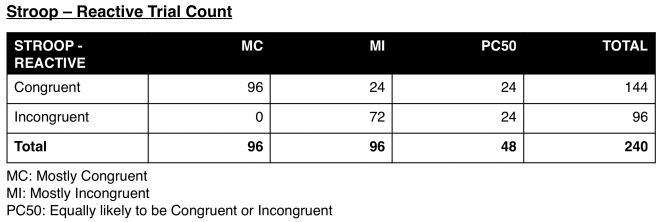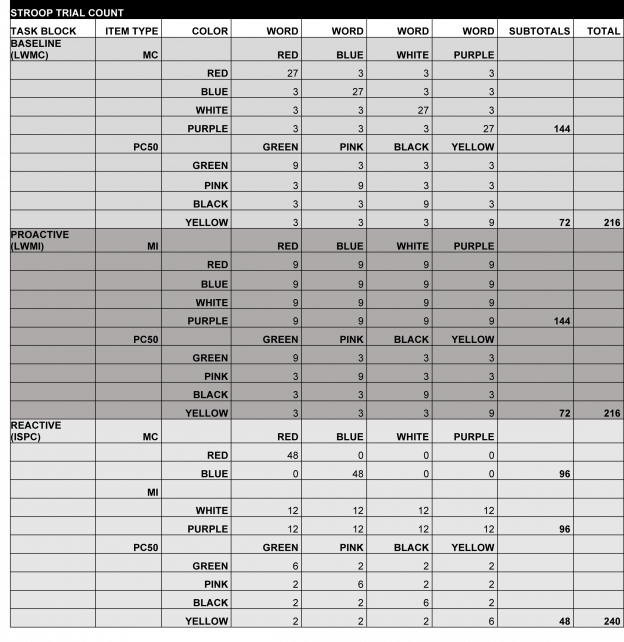The basic Stroop paradigm is one of the most widely used in experimental psychology and neuroscience to investigate goal-directed selective attention, inhibitory processing, and conflict resolution (and adaptation), along with other aspects of cognitive control. The most common experimental variant of the Stroop task is the color-word, in which stimuli are words presented in different colored fonts. The key distinction is between two different trial types: congruent in which the word name and font color are the same (e.g., the word RED presented in red font), and incongruent in which the word name indicates a different color than the font (e.g., the word RED presented in green font). Because word reading is thought to be a faster and more automatic cognitive process, it produces behavioral interference on incongruent trials (primarily slower RTs but also more errors). This interference pattern (measured in terms of incongruent – congruent performance differences), is referred to as the Stroop Effect. Another common variant is the picture-word Stroop, which produces the same interference pattern when trying to name (line-drawing) pictures with incongruent words superimposed. In most experimental variants (as opposed to clinical neuropsychological tests), the two types of trials are randomly intermixed. Although some variants use manual responses (with instructed response-mappings), a more standard, albeit technically more intensive approach is to use vocal responses (with voice onset latencies detected relative to stimulus onset), since these mappings are already very well learned.
Most theoretical frameworks assume that processing of incongruent trials requires increased cognitive control, in order to appropriately focus attention on the relevant dimension, to inhibit responding to the irrelevant dimension, and to resolve interference between the two. In the DMC framework, the primary assumption is that an advance expectation of interference should increase proactive control in the Stroop task.
A common technique to induce advance interference expectancy is the List-Wide Proportion Congruency (LWPC) manipulation. When most of the items in a block (list) of trials are incongruent, this condition is referred to as LWMI (list-wise mostly incongruent). In the DMC framework, LWMI conditions would be expected to be associated with higher levels of proactive control, with the control state maintained in a global, sustained, and anticipatory manner. In contrast, conditions in which most of the experienced items in a block (list) are congruent (LWMC) would be expected to be associated with lower levels of proactive control.
Proportion congruency manipulations can also be implemented at the level of individual items, such as for a particular font color. The important distinction with these Item-Specific Proportion Congruency (ISPC) manipulations is that they do not necessarily produce advance interference expectancies. In the DMC framework, MI items would be expected to be associated with higher levels of reactive control, as the demand for interference control is detected and implemented potentially more effectively for these items, but only at the time of stimulus presentation.


Stroop Baseline Table
In Gonthier et al (2016), we provided support for the hypothesis that proactive and reactive control can be independently engaged via LWPC and ISPC manipulations. This study utilized a picture-word Stroop variant, and also included a set of unbiased items (i.e., 50% proportion congruency; PC50) that were identical in all conditions, thus allowing for purer comparisons across conditions.
With the LWMC condition serving as the baseline, we demonstrated that there is improved cognitive control in both the LWMI (proactive) and ISPC (reactive) conditions, indexed as a reduced Stroop Effect. However, the LWMI and ISPC conditions were also doubly dissociable in terms of two novel and theoretically-motivated behavioral signatures, that we termed the congruency cost and the transfer cost.


Stroop Proactive Table
Our most current task paradigms provide additional optimizations to that implemented in Gonthier et al (2016), by: a) adopting the more common color-word Stroop; b) including better filler (100% congruent MC) items in the ISPC condition to ensure that it has high LWPC (thus reducing utilization of proactive control); and c) increasing the frequency of PC50 items (to improve reliability).


Stroop Reactive Table

Stroop Trial Count All Tasks
Below is relevant information regarding the available task-variants and conditions, in terms of the relevant procedures and parameters.
Behavioral Task Scripts
- Picture Word Version (Gonthier et al., 2016)
If you are interested in using the condition variants implemented in Gonthier et al (2016), please see that paper for details on all methods information.
Access Eprime task scripts and raw data - Web-based Color Word Version (currently unpublished)
This version includes baseline, proactive, and reactive conditions of the color-word Stroop. Reaction times and responses are measured via vocal responses captured through a voice triggered microphone.
Request access to the behavioral task scripts
Baseline
This condition implements a LWMC manipulation. There are 4 font colors in a set designated as MC, presented 75% of the time with a congruent word, and 25% with an incongruent word (equally distributed among the 3 remaining color word names of that set). A second set of 4 font colors is designated as PC50, presented 50% of the time with a congruent word, 50% with an incongruent word (again equally distributed among the other color word names of the PC50 set). The full condition includes 288 trials: 192 MC (144 congruent, 48 incongruent) and 96 PC50 (48 congruent, 48 incongruent). Across the condition, LWPC = 67%.
Proactive
This condition implements a LWMI manipulation. There are 4 font colors in a set designated as MI, presented 25% of the time with a congruent word, and 75% with an incongruent word (equally distributed among the 3 remaining color word names of that set). A second set of 4 font colors is designated as PC50, presented 50% of the time with a congruent word, 50% with an incongruent word (again equally distributed among the other color word names of the PC50 set). The full condition includes 288 trials: 192 MI (48 congruent, 144 incongruent) and 96 PC50 (48 congruent, 48 incongruent). Thus, across the condition, LWPC = 33%.
Reactive
This condition implements an ISPC manipulation. There are 2 font colors in a set designated as MI, presented 25% of the time with a congruent word, and 75% with an incongruent word (equally distributed among the 3 remaining color word names of that set). A second set of 4 font colors is designated as PC50, presented 50% of the time with a congruent word, 50% with an incongruent word (again equally distributed among the other color word names of the PC50 set). A final set of 2 font colors are designated as MC, presented 100% of the time with congruent words. These are used as filler items to produce a high LWPC. The full condition includes 480 trials: 192 MI (48 congruent, 144 incongruent), 96 PC50 (48 congruent, 48 incongruent), and 192 MC (all congruent). Thus, across the condition, LWPC = 60%. Note that this condition is longer than the other two, which is done to ensure enough exposure to MI items for strong reactive control to develop.
fMRI Task Scripts (currently unpublished)
This version includes baseline, proactive, and reactive conditions of the color-word Stroop. Reaction times are measured via vocal responses captured in stimulus-locked microphone recordings and saved as .wav files that are processed off-line (through in-house software, which does noise filtering) for response latency and accuracy. All conditions are implemented in a mixed block/event-related design. Within each scanning run, 3 task blocks alternate with 4 resting fixation blocks (30 sec duration); in each task block, the inter-trial interval randomly varies (across 3 step sizes).
Request access to the fMRI task scripts
Baseline
The same conditions and trial type frequencies are used as the behavioral version. The complete condition consists of 2 scanning runs, for a total of 216 trials: 144 MC (108 congruent, 36 incongruent) and 72 PC50 (36 congruent, 36 incongruent).
Proactive
The same conditions and trial type frequencies are used as the behavioral version. The complete condition consists of 2 scanning runs, for a total of 216 trials: 144 MI (36 congruent, 108 incongruent) and 72 PC50 (36 congruent, 36 incongruent).
Reactive
The same conditions and similar trial type frequencies are used as the behavioral version. The complete condition consists of 2 scanning runs, for a total of 240 trials: 96 MI (24 congruent, 72 incongruent), 96 MC (all congruent), and 48 PC50 (24 congruent, 24 incongruent). Note that this condition is slightly longer than the other two, which is done to generate sufficient MI items.
In addition to standard behavioral measures of RT and accuracy for each trial type, there are a number of derived measures that are useful for this task (for any of the above versions), which are described below. Additionally, it can be useful to calculate the internal consistency (as split-half reliability, Cronbach’s alpha, or ICC) for various measures, particularly if you plan to use these to investigate individual differences.
Stroop Effect
This computes the magnitude of behavioral interference measured as incongruent – congruent performance. It can be computed on RT and accuracy. The DMC framework predicts a reduction in Stroop effect magnitude in both proactive and reactive control conditions on MI items (LWMI for proactive, ISPC in reactive) relative to the baseline condition (MC items; LWMC). The Stroop effect can also be computed exclusively on PC50 items to test for list-wide (i.e., global/sustained) effects. In this case, the DMC framework predicts a Stroop effect reduction only for the proactive condition.
Congruency Cost
There are multiple possible ways to compute this cost, which are still the focus of investigation. Currently, we suggest computing this on PC50 congruent items, subtracting out PC50 congruent items from the baseline (LWMC) to produce the cost measure. The DMC framework predicts a higher congruency cost in the proactive condition than in the reactive condition.
Transfer Cost
There are multiple possible ways to compute this cost, which are still the focus of investigation. Currently, we suggest computing this as the difference between PC50 incongruent items and MI incongruent items. Additionally, the transfer pattern in the baseline condition can be further subtracted out (PC50 incongruent – MC incongruent) to further normalize this measure. The DMC framework predicts a higher transfer cost in the reactive condition than in the proactive condition.